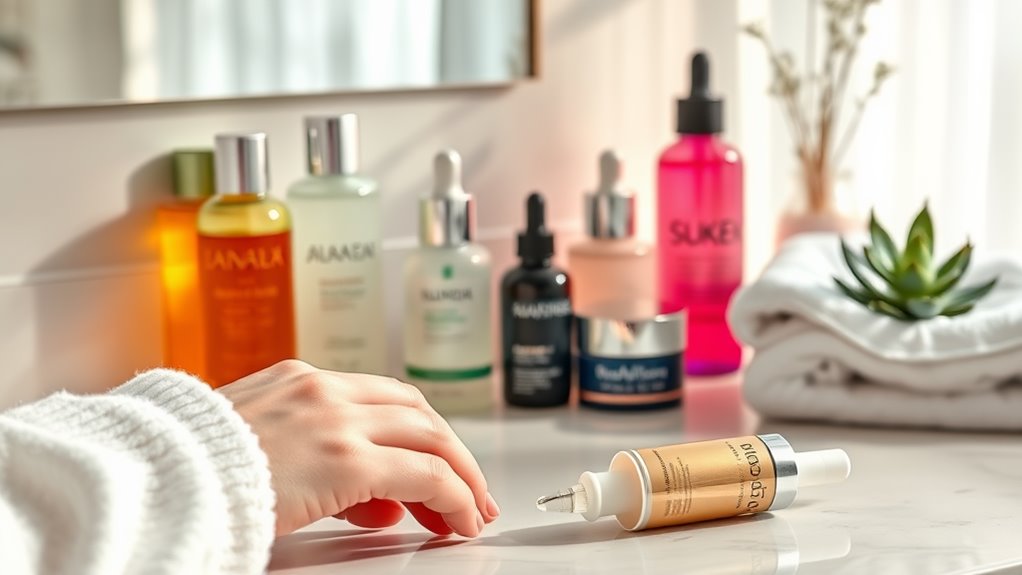Stop Using the Wrong Products for Your Skin Type
Using the wrong skincare products for your skin type can wreak havoc on your complexion. If your skin’s irritated, breaking out, or feeling dry, it’s a sign you need to reassess your products. Identify your skin type—oily, dry, combination, or sensitive—and avoid ingredients that aggravate it, like heavy oils for oily skin or sulfates for dry skin. Shifting to the right products can transform your routine. Discover the essential steps to maintain healthy skin long-term.
Key Takeaways
- Identify your skin type (oily, dry, combination, or sensitive) to choose suitable products.
- Monitor your skin’s reactions to products for signs of irritation or dryness.
- Avoid heavy oils and comedogenic ingredients if you have oily or acne-prone skin.
- Patch test new products on a small area to prevent adverse reactions.
- Adjust your skincare routine based on seasonal changes and your skin’s evolving needs.
Understanding Different Skin Types
How well do you know your skin? Understanding your skin type is essential for effective skincare. Each type—oily, dry, combination, or sensitive—has unique needs.
You can’t just grab any product off the shelf; doing so could lead to a wrong product fix that damages your skin. For instance, if you have oily skin, using heavy creams can exacerbate breakouts. Conversely, dry skin craves hydration, so lightweight formulas mightn’t suffice.
To master your skincare routine, identify your skin type and tailor your product choices accordingly. Pay attention to how your skin reacts; it’ll guide you in selecting the right ingredients. Additionally, recognizing how different skin types react to specific products can help you make informed decisions about your skincare regimen.
Signs You’re Using the Wrong Products
Are you noticing unexpected changes in your skin despite sticking to a routine? This could be a clear sign that you’re using the wrong products.
If your skin feels irritated, itchy, or overly dry, it’s time to reassess what you’re applying. Breakouts that seem to appear out of nowhere or stubborn dryness can indicate that your products don’t align with your skin’s needs.
Additionally, if your skin looks dull or lacks radiance, it might be craving nourishment that your current regimen isn’t providing.
Pay attention to how your skin reacts after each application; any redness or discomfort isn’t normal. Understanding your true skin type is crucial for selecting the right products.
Mastering your skincare routine starts with recognizing these signals and making the necessary adjustments for ideal skin health.
How to Determine Your True Skin Type
To find your true skin type, you need to observe how your skin reacts throughout the day. You can also conduct a simple skin test at home or consult a skincare professional for expert advice. Understanding your skin’s behavior is key to choosing the right products for your needs. Additionally, using the bare-faced method can help you accurately identify your skin type and tailor your skincare routine accordingly.
Observe Your Skin’s Behavior
Ever wondered what your skin’s true type is? Observing your skin’s behavior can reveal a lot. Pay attention to how your skin reacts to products and environmental changes. For instance, does it feel tight after cleansing, or does it shine with excess oil?
Here’s a quick guide to help you identify your skin type based on its behavior:
| Skin Characteristic | Possible Skin Type |
|---|---|
| Oily and shiny | Oily |
| Flaky and tight | Dry |
| Combination of both | Combination |
| Smooth and balanced | Normal |
Conduct a Skin Test
How can you gain a clearer understanding of your skin type? Conducting a simple skin test can reveal invaluable insights.
Start by cleansing your face thoroughly to remove any products. Wait for about an hour, allowing your skin to return to its natural state.
After this, observe how your skin feels. If it’s tight and flaky, you might’ve dry skin. Oily skin usually appears shiny, especially in the T-zone. Combination skin will feel oily in some areas and dry in others. If your skin feels comfortable, you likely have normal skin.
This test provides a foundation for selecting appropriate products, ensuring you cater to your skin’s specific needs for ideal health and appearance.
Consult a Skincare Professional
Once you’ve conducted a skin test, consulting a skincare professional can provide deeper insights into your skin type.
They’ll assess your skin’s unique characteristics, helping you understand its needs beyond what a simple test can reveal. By evaluating factors like hydration levels, elasticity, and sensitivity, they can accurately identify any underlying issues, such as dryness or excess oil production.
Moreover, a professional can recommend tailored products and treatments that align with your goals.
They’ll offer expert advice on ingredient compatibility, ensuring you avoid potential irritants.
Remember, the right guidance can notably enhance your skincare routine, enabling you to achieve that healthy glow you crave.
Invest the time in this consultation; your skin deserves the best.
Common Ingredients to Avoid for Specific Skin Types
When selecting skin products, it’s essential to recognize that certain ingredients can exacerbate issues based on your skin type.
If you have oily or acne-prone skin, steer clear of heavy oils and comedogenic ingredients like coconut oil or lanolin, which can clog pores.
For sensitive skin, avoid fragrances and alcohol, as they can cause irritation and redness.
If your skin is dry, skip products with sulfates or harsh exfoliants that strip moisture.
Those with combination skin should be cautious with overly rich creams that can lead to breakouts in oily areas. Additionally, understanding common face-washing mistakes can help you develop a routine that enhances your skin’s health.
Transitioning to the Right Skincare Products
When shifting to the right skincare products, you first need to identify your skin type. Look for ingredients that cater specifically to your needs, and don’t forget the importance of patch testing new products. This careful approach can help you avoid irritation and achieve healthier skin. Additionally, understanding your specific skin type is crucial for selecting the most effective products tailored to your unique skincare needs.
Identify Your Skin Type
How can you choose the right skincare products if you don’t know your skin type? Identifying your skin type is essential for effective skincare.
Start by observing how your skin behaves throughout the day. If it feels tight and flaky, you likely have dry skin. Oily skin tends to shine and may have enlarged pores. Combination skin shows both oily and dry areas, while sensitive skin reacts easily to products and environmental factors.
To assess, cleanse your face and wait an hour. Notice any changes in texture or oiliness. Don’t forget to take into account seasonal changes, as your skin may shift with the weather.
Once you’ve pinpointed your skin type, you’ll be better equipped to select products tailored to your unique needs.
Ingredients to Look For
Now that you know your skin type, it’s time to focus on the ingredients in skincare products that best suit your needs. Selecting the right components can elevate your routine and yield remarkable results.
Here are three essential ingredients to look for:
-
Hyaluronic Acid – Ideal for hydration, it attracts moisture to the skin, making it perfect for dry skin types.
-
Salicylic Acid – This is a must for oily or acne-prone skin, as it helps unclog pores and reduce breakouts.
-
Vitamin C – A powerful antioxidant that brightens skin and evens tone, suitable for all skin types seeking a radiant glow.
Patch Testing Importance
Have you ever experienced a reaction after trying a new skincare product? It can be frustrating and disheartening.
That’s why patch testing is essential before fully committing to any new product. By applying a small amount to a discreet area of your skin, you can gauge how your skin reacts without risking a full-face mishap.
This simple step helps you identify potential irritants and allergens, ensuring you’re not blindly trusting the claims on the label.
Remember, everyone’s skin is unique, and what works for someone else mightn’t work for you.
Embrace patch testing as an integral part of your skincare routine, and you’ll master the art of selecting products that truly benefit your skin type.
Building a Skincare Routine for Your Skin Type
What elements should you consider when building a skincare routine tailored to your skin type?
First, identify your skin type—whether it’s oily, dry, combination, or sensitive. This foundation guides your product choices.
Next, focus on three essential steps:
-
Cleansing: Use a gentle cleanser that effectively removes dirt and makeup without stripping moisture.
-
Moisturizing: Select a moisturizer suited for your skin type; lightweight gel for oily skin or a richer cream for dry skin.
-
Sun Protection: Always apply a broad-spectrum sunscreen during the day to shield your skin from harmful UV rays.
Tips for Maintaining Healthy Skin Long-Term
While building a skincare routine is essential, maintaining healthy skin long-term requires consistent habits and mindful choices.
Prioritize hydration by drinking plenty of water; it’s vital for skin elasticity and overall health. Incorporate a balanced diet rich in antioxidants, vitamins, and healthy fats to nourish your skin from within.
Don’t underestimate the power of regular exercise; it boosts circulation and helps detoxify your skin. Establish a routine for sun protection; daily application of broad-spectrum SPF is non-negotiable.
Regularly exfoliate to remove dead skin cells and promote cell turnover, but avoid overdoing it. Finally, listen to your skin; adjust your products and habits based on its changing needs.
Master these practices, and you’ll cultivate resilient, radiant skin.
Frequently Asked Questions
Can My Skin Type Change Over Time?
Yes, your skin type can change over time due to factors like age, hormones, climate, and lifestyle. Regularly evaluating your skin’s needs helps you adapt your routine for ideal health and appearance. Stay attentive!
How Often Should I Change My Skincare Products?
You should evaluate your skincare products every three to six months. Factors like seasonal changes, skin condition, or new concerns may require adjustments. Regularly reassess what works best for you to maintain ideal skin health.
Are Natural Products Better for My Skin Type?
Natural products can be beneficial, but it depends on your skin type and concerns. You should evaluate ingredients and how your skin reacts, ensuring they align with your specific needs for ideal results.
Can I Use the Same Products for Day and Night?
You can use the same products for day and night, but it’s often better to tailor your routine. Day products should focus on protection, while night products should emphasize repair and hydration for ideal results.
What Should I Do if I Experience Irritation?
If you experience irritation, you should immediately stop using the product causing it. Cleanse your skin gently, apply a soothing moisturizer, and consider consulting a dermatologist for tailored advice on managing your skin’s needs effectively.





